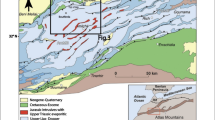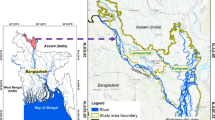Abstract
The main focus of this research is to detect vulnerabilities on the Mississippi river levees using remotely sensed Synthetic Aperture Radar (SAR) imagery. Unstable slope conditions can lead to slump slides, which weaken the levees and increase the likelihood of failure during floods. On-site inspection of levees is expensive and time-consuming, so there is a need to develop efficient automated techniques based on remote sensing technologies to identify levees that are more vulnerable to failure under flood loading. Synthetic Aperture Radar technology, due to its high spatial resolution and potential soil penetration capability, is a good choice to identify problem areas along the levee so that they can be treated to avoid possible catastrophic failure. This research analyzes the ability of detecting the slump slides on the levee with NASA JPL’s Uninhabited Aerial Vehicle Synthetic Aperture Radar (UAVSAR) data. The main contribution of this research is the development of a machine learning framework to (1) provide improved knowledge on the status of the levees, (2) detect anomalies on the levee sections, (3) provide early warning of impending levee failures, and (4) develop efficient tools for levee health assessment. Textural features have been computed and utilized in the classification tasks to achieve efficient levee characterization. The RX anomaly detector, a training-free unsupervised classification algorithm, detected the active slides on the levee at the time of image acquisition and also flagged some areas as “anomalous,” where new slides appeared at a later date.











Similar content being viewed by others
References
Baghbidi M Z, Jamshidi K, Nilchi A R N, Homayouni S (2011) Improvement of anomaly detection algorithms in hyperspectral images using discrete wavelet transform. Signal Image Process: Int J 2(4)
Bonn F, Dixon R (2005) Monitoring flood extent and forecasting excess runoff risk with RADARSAT-1 data. Nat Hazards 35:377–393
Chan YK, Koo VC (2008) An introduction to synthetic aperture radar (SAR). Prog Electromagn Res B 2:27–60
Chang C-I, Chiang, S-S (2002) Anomaly detection and classification for hyperspectral imagery. IEEE Trans Geosci Remote Sens 40(6)
Corps of Engineers Water Resources Infrastructure (2012) National Research Council. National Academies Press
Cruden DM, Varnes DJ (1996) Landslides: investigation and mitigation. Chapter 3 – landslide types and processes. Transp Res Board, Spec Rep 247:36–75
Cui M, Prasad S, Mahrooghy M, Aanstoos J V, Lee M A, Bruce L M (2012) Decision fusion of textural features derived from polarimetric data for levee assessment. IEEE J Sel Top Appl Earth Obs Remote Sens 5(3)
Dabbiru L, Aanstoos JV, Mahrooghy M, Li W, Shanker A, Younan NH (2012) Levee anomaly detection using polarimetric synthetic aperture radar data. IEEE International Geoscience and Remote Sensing Symposium, Munich, pp 5113–5116
Dunbar J (2011) The use of airborne geophysics for levee classification and assessment. Dissertation, University of Delaware
Flor A, Pinter N, Remo Jonathan W F (2010) Evaluating levee failure susceptibility on the Mississippi River using logistic regression analysis. Elsevier. Engineering Geology
Freeman A, Durden S L (1998) A three-component scattering model for polarimetric SAR data. IEEE Trans Geosci Remote Sens 36(3)
Fukuda S, Hirosawa H (1999) A wavelet-based texture feature set applied to classification of multifrequency polarimetric SAR images. IEEE Trans Geosci Remote Sens 37(5)
Fukuda S, Hirosawa H (2001) Support vector machine classification of land cover: application to polarimetric SAR data. IEEE 0-7803-7031-7/01.
Hanssen R F, van Leijen F J (2008) Monitoring water defense structures using radar interferometry. IEEE Radar Conf
Jensen A, Cour-Harbo A (2001) Ripples in mathematics—the discrete wavelet transform. Springer
Jones C E, Bawden G, Deverel S, Dudas J, Hensley S, Yun S-H (2012) Study of movement and seepage along levees using DINSAR and the airborne UAVSAR instrument. Proc. SPIE 8536, SAR Image Analysis Modeling, and Techniques XII, 85360E
Liu C (2010) A tutorial of the wavelet transform. NTUEE, Taiwan
Lu CS, Chung PC, Chen CF (1997) Unsupervised texture segmentation via wavelet transform. Pattern Recogn 30(5):729–742
Mistry D, Banerjee A (2013) Discrete wavelet transform using matlab. Int J Comput Eng Technol (IJCET) 4(2)
Nasrabadi MN (2008) A nonlinear kernel-based joint fusion/detection of anomalies using hyperspectral and SAR imagery. IEEE International Conference on Image Processing, San Diego, pp 1864–1867
Ohel E, Rotman SR, Blumberg DG (2006) Multipixel anomaly detection in noisy multispectral images. Opt Eng 45(2):023604
Rignot E, Chellappa R, Dubois P (1992) Unsupervised segmentation of polarimetric SAR data using the covariance matrix. IEEE Trans Geosci Remote Sens 30(4)
Rosen PA, Hensley S, Wheeler K, Sadowy G, Miller T, Shaffer S, Muellerschoen R, Jones C, Zebker H, Madsen S (2006) UAVSAR: a new NASA airborne SAR system for science and technology research. IEEE Radar Conference, Verona, p 8
Sehat S, Vahedifard F, Aanstoos JV, Dabbiru L, Hasan K (2014) Using in situ soil measurements for analysis of a polarimetric SAR-based classification of levee slump slides in the Lower Mississippi River. Eng Geol 181:157–168. doi:10.1016/j.enggeo.2014.07.007
USACE United States Army Corps of Engineers (2000) Design and construction of levees. EM 1110-2-1913.
USACE United States Army Corps of Engineers (2014) Mississippi River and Tributaries Project, Levee system evaluation report for the national flood insurance program. http://www.mvd.usace.army.mil/Portals/52/docs/MRC/LeveeSystem/MRT_levee_system_eval_report_for_NFIP.pdf
Varnes DJ (1978) Slope movement types and processes. Transportation Research Board special report no. 176. Natl Acad Sci, pp 11–33
Wang Y, Song Q, Jin T, Huang X, Zhang H (2013) A novel minefield detection approach based on morphological diversity. Prog Electromagn Res 136:239–253
Yu X, Hoff LE, Reed IS, Chen AM, Stotts LB (1997) Automatic target detection and recognition in multispectral imagery. IEEE Trans Image Process 6:143–156
Acknowledgment
This material is based upon work supported by the National Science Foundation under Award No. OISE – 1243539. The authors would like to thank the US Army Corps of Engineers, Engineer Research and Development Center and Vicksburg Levee District for providing ground truth data and expertise; and also NASA Jet Propulsion Laboratory for providing the UAVSAR images.
Author information
Authors and Affiliations
Corresponding author
Rights and permissions
About this article
Cite this article
Dabbiru, L., Aanstoos, J.V. & Younan, N.H. Earthen levee slide detection via automated analysis of synthetic aperture radar imagery. Landslides 13, 643–652 (2016). https://doi.org/10.1007/s10346-015-0599-9
Received:
Accepted:
Published:
Issue Date:
DOI: https://doi.org/10.1007/s10346-015-0599-9




